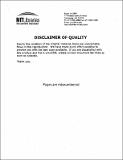Air-gap sacrificial materials by initiated chemical vapor deposition
Author(s)
Lee, Long Hua
DownloadFull printable version (10.34Mb)
Other Contributors
Massachusetts Institute of Technology. Dept. of Chemical Engineering.
Advisor
Karen K. Gleason.
Terms of use
Metadata
Show full item recordAbstract
P(neopentyl methacrylate-co-ethylene glycol dimethacrylate) copolymer, abbreviated as P(npMAco-EGDA), was selected as the potential air-gap sacrificial material among possible combination of twenty monomers and four crosslinkers. P(npMA-co-EGDA) was deposited onto substrates using initiated chemical vapor deposition (iCVD) technique. Spectroscopic data showed the effective incorporation of both components in the copolymer and the integrity of repeating units were retained. The onset temperature of decomposition of P(npMA-co-EGDA) copolymer could be tuned between 290-3500C by varying the composition of the copolymer. The removal rate of polymer was calculated based on interferometry signal-time curve. The activation energy was determined by fitting the rate of decomposition with logistic model and found to be 162.7+8kJ/mole, which was similar to published data. Flash pyrolysis gas chromatography mass spectroscopy analysis showed that the products of thermal decomposition are monomers, rearranged small molecules and low oligomers. The modulus and the hardness were in the range of 3.9 to 5.5 GPa and 0.38 to 0.75 GPa, respectively, and were higher than those of linear poly(methyl methacrylate) (PMMA). Air-gap structures were constructed in the following scheme: P(npMA-co-EGDA) was deposited on the substrate by iCVD, followed by spincasting PMMA electron beam resist and scanning electron beam lithography to implement patterns on the resist. Reactive ion etching (RIE) was then applied to simultaneously etch the PMMA resist and P(npMA-co-EGDA) sacrificial material away in a controlled manner, leaving the patterned sacrificial material on the substrate. (cont.) A layer of porous silica was deposited to cover the substrate and the patterned sacrificial material by plasma-enhanced chemical vapor deposition (PECVD) at 2500C and the sample was thermally annealed to allow the decomposed fragments to diffuse through the overlayer of silica. Using the scheme described above, it was possible to construct air-gap structures with feature size of 200nm and feature height of 1 00nm.
Description
Thesis (S.M.)--Massachusetts Institute of Technology, Dept. of Chemical Engineering, 2007. Includes bibliographical references (leaves 81-83).
Date issued
2007Department
Massachusetts Institute of Technology. Department of Chemical EngineeringPublisher
Massachusetts Institute of Technology
Keywords
Chemical Engineering.